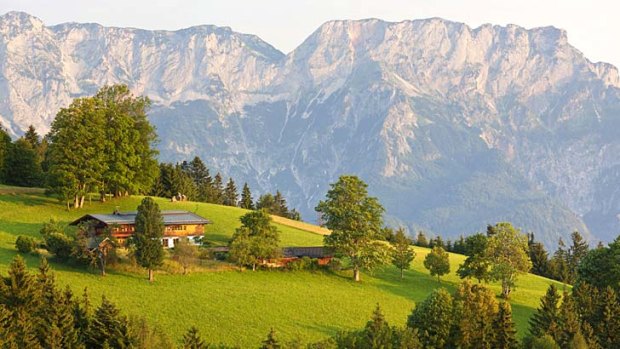
Salzburg's very own pet mountain ... Untersberg.Credit: Getty Images
From Mozart and The Sound of Music to skiing and saltmines, this is the best on offer in Salzburg.
1 Mozart
A certain Wolfgang Amadeus Mozart is Salzburg's most famous son, and the city isn't exactly reticent when it comes to shouting about this. Mozart's birthplace at 9 Getreidegasse is now a museum, and it does a decent job of taking visitors through the composer's (surprisingly short) life and work. Among the original documents, paintings and instruments, you start to realise that it wasn't all about young Wolfie's talent - a pushy father and a wife with considerable marketing nous helped create the legend, too. mozarteum.at.
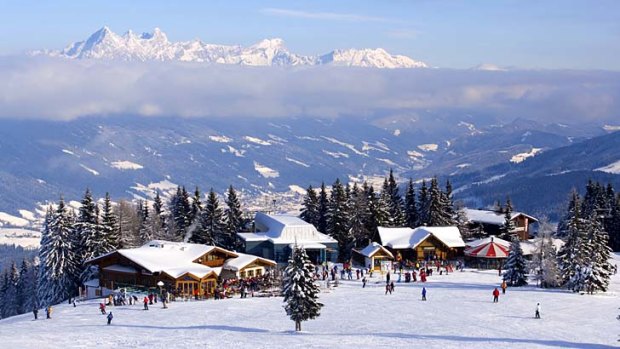
In the foothills of the Alps ... Flachau near Salzburg.Credit: Getty Images
2 The Sound of Music
Salzburg's less highbrow musical claim to fame is that it was the setting for Julie Andrews and her cherub-voiced charges in one of the most successful films of all time. The Sound of Music is the city's cash cow, and numerous tours will take you around the various sites the film's cast warbled in. These include the lake outside Schloss Leopoldskron, the Nonnberg Convent and the Do-Re-Mi fountain in the Mirabell Palace Gardens. Fraulein Maria's Bicycle Tours provides the healthy option, with the bonus of access to the bits the tour buses aren't allowed to reach. mariasbicycletours.com.
3 Classical cuisine
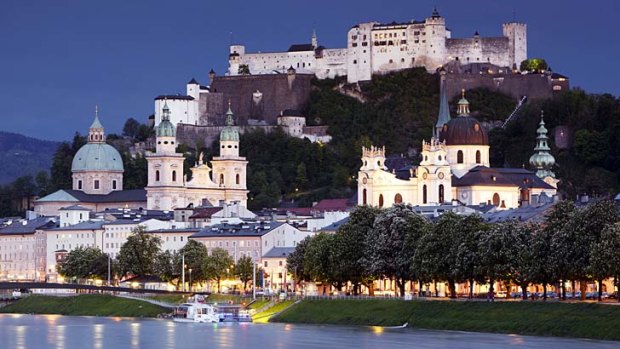
Hohensaltzburg Fortress ... dates back to the 11th century.Credit: Getty Images
Predictably enough, you can listen to pretty much every note Mozart ever penned while in the city. Regular formal performances are held, but the casual enthusiast may prefer a greatest-hits selection over dinner. The Baroque Hall at the St Peter's Stiftskeller hosts a three-course meal interspersed with chunky excerpts from Don Giovanni, The Marriage of Figaro and The Magic Flute - with the five-piece string section, divo and diva in period dress. stpeter-stiftskeller.at/en.
4 Untersberg
The last scene in The Sound of Music - of the von Trapps escaping the Nazis by toddling off over the Alps - was filmed at Salzburg's very own pet mountain. Ironically, they would have actually been going into Germany - the border separating Austria and Bavaria passes through Untersberg. On a clear day, it's a truly magical place, however. The cable car up is something of a thrill ride, while the 360-degree views of mountains, city and plains from up top on the hiking trails make the soul sing. untersbergbahn.at.
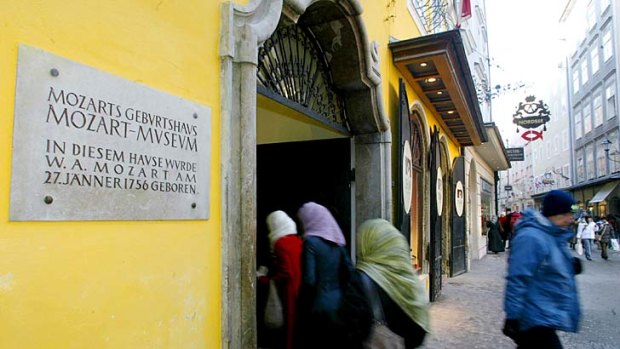
Salzburg's claim to fame ... Mozart's birthplace.Credit: AFP
5 The Residenz
It's done very differently, but the palace of Salzburg's former ruling prince-archbishops also rocks the baroque look for which the city is known. A stroll through the rooms shows a consistency that can be absent from other European palaces, with just about every space having wedding cake-esque swirls framing large ceiling frescoes. The Bilder Galerie is the standout, with one giant, all-consuming artwork stretching across the ceiling and combining symbols from all four of the continents that were known at the time of painting.
6 Salzburger Dom
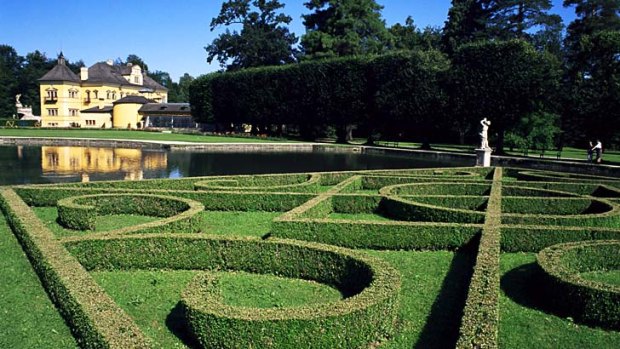
Sumer palace ... Schloss Hellbrunn.Credit: Getty Images
Salzburg's cathedral is a high baroque masterpiece, and it's worth sitting down in the pews to let it soak in. Taking it as a whole, you suddenly realise that it's not the ceiling frescoes or enormous pipe organ that make it special - it's the black-and-white stucco work around the numerous arches. It's dazzlingly detailed, but so clean and crisp at the same time. You feel like you're looking at something in such high definition that no photograph could ever do it justice.
7 Schloss Hellbrun
One of those prince-archbishops was the rather childish Markus Sittikus, who built himself a big summer palace on the outskirts of the city and then got inventive with the gardens. A water-powered mechanical theatre, where more than 200 wooden figures burst into life at regular intervals, is somewhat overshadowed by the numerous trick fountains. Sittikus designed these to catch out guests, and they still do - expect to be soaked from the most unlikely sources. hellbrunn.at.
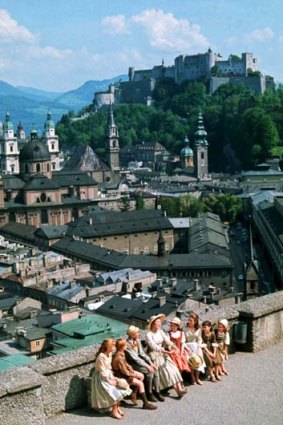
Filmed in Salzburg ... The Sound of Music.
8 The Salzburg Festival
One of Europe's greatest annual cultural events, the Salzburg Festival turns the city into a highbrow hub from late July until the end of August. Big-name international orchestras and soloists are brought in, while operas and plays are staged both in, and in front of, many of the city's landmark buildings. These include the Residenz and the Dom. Buy tickets well in advance or expect to pay a fortune via wangling concierges.
9 Skiing
Salzburg is just in the foothills of the Alps, but there's a daily snow shuttle out to the Flauchen ski region. It's perfect for occasional skiers and boarders who want to explore the city and the piste equally - and there's the bonus of Salzburg hotel rates being lower in the winter while the resorts jack prices up. salzburgerfestspiele.at.
10 Casino Salzburg
Don't ditch the jacket and tie as soon as the symphony's finished - you'll need them to get into Schloss Klessheim. Designed by Johann Bernhard Fischer von Erlach, who knocked up many of the old town's most impressive buildings, this baroque palace is now a grand casino. Think more Monte Carlo than Melbourne if you're planning a night on the tables.
11 Hohensalzburg Fortress
Given that it dates back to the 11th century, the sparkling white fortress that looks over the city is in remarkably good shape. Most visitors are happy just to get the funicular up, mooch around the warren of interconnected yards and admire the view from one of Europe's finest castles. But the museums inside, which cover everything from marionettes to torture as well as the city's complex history, are engaging once the eye candy has been dealt with.
12 Museum der Moderne
Stroll across the Monchsberg hill from the fortress and you arrive at one of Europe's most exciting art venues. The museum hosts only rotating exhibitions, but consistently pulls in some of modern art's biggest names - from Gilbert and George to David LaChapelle - for ambitiously themed short runs. The on-site restaurant is regarded as one of Salzburg's finest, too.
13 Public art
Many of these courtyards are also home to the fruits of the Salzburg Foundation's program of installing one major piece of modern art each year. Privately operated and funded, the foundation's efforts stop Salzburg from feeling like a walk-through museum. The installations make for a good walking trail, with Stephan Balkenhol's Sphaera - a man standing on top of a giant golden ball - in Kapitelplatz being a firm favourite. Others include the gherkins in Furtwangler Park and Jaume Plensa's enigmatic five-metre-high marble head, Awilda. salzburgfoundation.at.
14 Shops with staying power
The old town is a delight to wander through, but not just for its concentration of gorgeous churches and sprawling squares. The major chains may be creeping in, but Salzburg still has a collection of long-standing independent boutiques, antique shops and confectioners. Expertise is the name of the game for shopping here, with specialists in umbrellas, musical instruments, handmade shoes, porcelain and metalwork still pulling in the punters after decades - often centuries - of quality service. Getreidegasse and Goldgasse host a large percentage of the shopping stars, but be sure to duck into the courtyards, too.
15 Historic hotels with an arty twist
The new-ideas-in-old-setting vibe continues with two hugely impressive art hotels. The 15-room Hotel Am Dom has kept the vaulted ceilings of the mid-13th century building it occupies, and razzle-dazzled the place up with blisteringly colourful photo-montage artworks, talking-point light fittings and a general decadent swagger. The Blaue Gans is slightly more subdued, but displays the works from the artists it regularly hosts, and transforms a 661-year-old inn with an odd combo of Scandinavian-style woods and feistily modern bright-green plastics. hotelamdom.at and hotel-blaue-gans-salzburg.at.
16 The Eisriesenwelt
Dubbed the world's largest ice cave, this extraordinary Narnia-like world is accessed high up on a mountain near the village of Werfen. You'll need a bus, utterly terrifying cable-car ride and a 40-minute uphill hike, but the views on the way alone make the excursion worth it. Once inside, you tackle 1400 steps around ice walls, tunnels and a bizarre polar bear-shaped stalagmite and stalactite formation. Think of an underground glacier positioned high above a deep valley, and you're about there. panoramatours.com.
17 Mozart balls
Salzburg's best-known delicacies are the moreish balls of chocolate, marzipan and pistachio that can be found in virtually every shop in central Europe. But those that are still partially handmade to the authentic recipe are available only at the original Furst cafe at 13 Brodgasse and a couple of other outlets bearing the same name. Confectioner Paul Furst invented the treat, but foolishly forgot to patent it. original-mozartkugel.com.
18 The Red Bull restaurant trio
The Red Bull energy drink mogul Dietrich Mateschitz is behind three highly distinctive dining experiences in Salzburg. In the old town, Afro Cafe mixes a modern urban look with a distinctive African twist, while Carpe Diem specialises in "the finest finger food" - in essence mini meals, created by celeb chef Jorg Worther, that are wrapped up in edible cones. Hangar-7, at the airport, is the boldest, however. Meals are prepared according to detailed nutritional research, while the glass-and-steel building hosts a sizeable and showy private aircraft collection.
19 Saltmines
Salzburg's wealth - and, indeed, its name - originally came from the saltmines in the city's surrounding region. A few of them are open to tourists, but the most impressive is 26 kilometres south in the German town of Berchtesgaden. You travel through the 500-year-old mine on little trains, miner's slides, funiculars and - at one point - on a raft over an underground lake. A giant salt shrine and a high-tech educational centre are among the thoroughly spectacular subterranean highlights. salzzeitreise.de.
20 Augustiner Braustubl
The food's less gourmet here - you order hearty favourites from counters - but it's the beer and the setting you come for. The beer is poured out of wooden barrels into one-litre and half-litre stoneware mugs, and everyone gets together in four huge underground beer halls to drink it. The brewery was established in 1621, and the Augustiner Braustubl is inside the monastery. And, to top things off, it is also home to Salzburg's largest beer garden. augustinerbier.at.
David Whitley was a guest of Tourism Salzburg (salzburg.info).
Sign up for the Traveller Deals newsletter
Get exclusive travel deals delivered straight to your inbox. Sign up now.